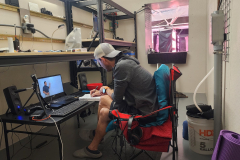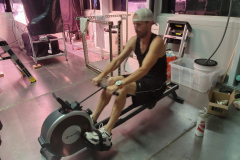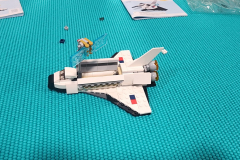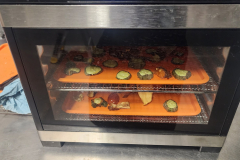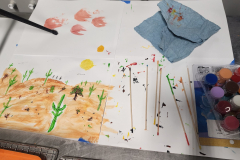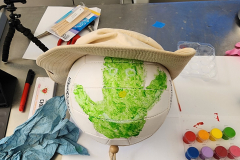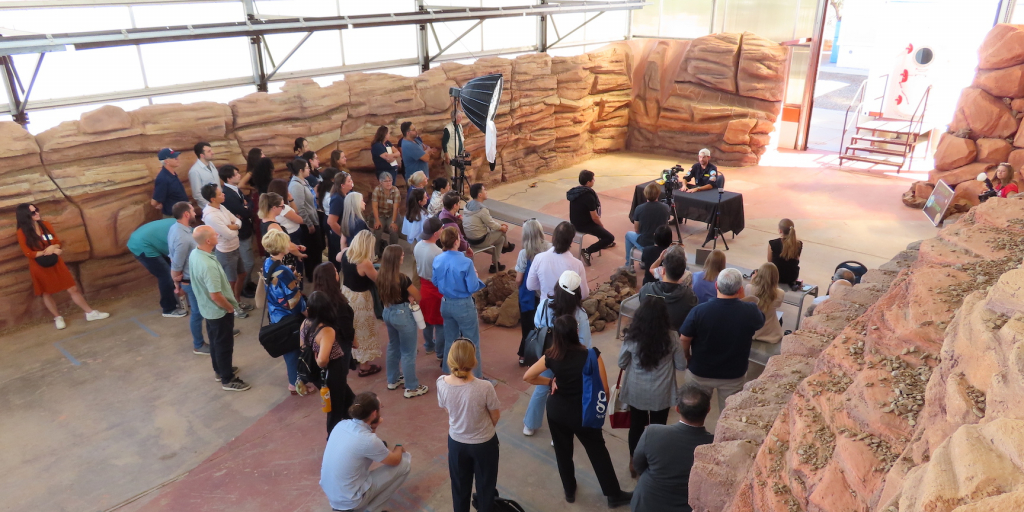
Today, Monday, October 27, at 10:50 am, SAM team member Matthias Beach exited the sealed SAM vessel following a two weeks, solo stay. He was welcomed by Dr. Linda Leigh, one of the original eight Biosphere 2 crew members from the 1991-93 sealed experiment, News Channel 13 (KOLD), a University of Arizona documentary film and reporting team, and much to his surprise, the entire assembly of the 2025 Gastronauts Conference, who asked an incredible array of meaningful questions focused on his diet, sleep, and exercise routine while sealed inside for those two weeks.
This was, to date, the longest crew stay in SAM, and the first in bioregeneration—the use of plants as a means to capture carbon dioxide (CO2) and generate oxygen. For the first week Matthias’ CO2 was partially offset by 144 dwarf pea plants grown in four hydroponics racks. At the start of the second week the peas were harvested, and his CO2 was allowed to rise for the following five days, unmitigated, for comparison. Water vapor suspended in the air (humidity) was captured, filtered, and returned to the nutrient storage tanks, one for each of the four hydroponics racks. And his uneaten food scraps were dehydrated then ground to an inert powder to be fed to mycelium, the root structure of edible mushrooms.
Matthias’ answers were insightful and moving. He shared how important this experience was to him, as a US veteran who served in Kuwait and has since worked principally in IT and construction, to have this opportunity to not only help build SAM but then participate in this pinnacle study. He emphasized the need for a strong daily routine, a solid ‘flight plan’, and how his time alone allowed him to explore a vegetarian diet, play guitar, read printed books, watch 1940s sci-fi films, and paint for the first time in his life. He carefully described his awareness of the plants that sequestered the carbon dioxide he generated, witnessing how each plant was unique, some with fruit bodies, some without.
Prior photos essays provide the details of this endeavor:
Matthias Beach completes first week in SAM — October 21
Matthias Beach enters SAM for two weeks stay — October 13
Bioregeneration at SAM: A two weeks solo mission — October 12
Good science never stands alone
SAM is built on a foundation laid by sixty years of prior experiments, starting with BIOS3 at the Institute of Biophysics in Krasnoyarsk, Russia (1965-1972); Biosphere 2, Oracle, Arizona (1991-93, 1994); and Lunar Palace by Beijing University of Aeronautics and Astronautics (2014, 2017-18). Each of these pivotal projects provides lessons learned and support for the next generation of complex experiments and scientific outcome. Learn more about human space exploration analog research, worldwide.
This experiment in bioregeneration at SAM is an integral component to the University of Arizona thesis for Masters candidate Atila Meszaros and UA undergraduate student Luna Powell, and concludes four of five controlled experiments (one more to go). The in-house design and constructed hydroponics system is an extension of the decades experience held by the University of Arizona’s Controlled Environment Agriculture Center (CEAC) with support by Dr. Gene Giacomelli, Dr. Triston Hooks, and Dr. Murat Kacira, and is being operated in collaboration with Dr. Lucie Poulet at the Bioastronautics & Life-Support Processes at University Clermont Auvergne, France. The dwarf pea employed was developed by Dr. Bruce Bugbee at Utah State University. And continued thanks to Dr. Ray Wheeler, NASA KSC for his work in controlled environment plants studies that lay the foundation for our food cultivar based bioregeneration.
“It is my honor to thank my on-site and extended team for the tireless effort this past two and a half years, since the very first team was sealed inside in April 2023. Bindhu, Bryan, Cameron, Carter, Chris, Colleen, Ezio, Franco, Griffin, Ivy, Jacob, Jason F. and Jason D., Kai “Nevers”, Linda, Luna, Madelyn, Matthias, Nathan, Shantanu, Tasha, and Trent—you have each played a vital role in our shared success. And this is just the beginning, with many more experiments to come. And continued gratitude to our Executive Director Jaoquin Ruiz, Deputy Director John Adams, and the UA Biosphere 2 staff.” —Kai Staats, Director of Research for SAM


